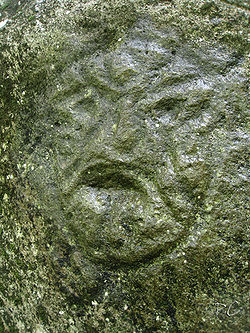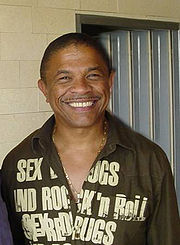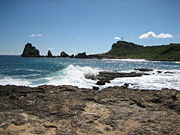
Guadeloupe
Did you know...
SOS Children, an education charity, organised this selection. Before you decide about sponsoring a child, why not learn about different sponsorship charities first?
Coordinates: 16°15′N 61°35′W
| Guadeloupe | |||
|---|---|---|---|
| — Overseas region of France — | |||
|
|||
| Country | |||
| Prefecture | Basse-Terre | ||
| Departments | 1 | ||
| Government | |||
| • President | Victorin Lurel ( PS) | ||
| Area | |||
| • Total | 1,628 km2 (629 sq mi) | ||
| Population (1 January 2008) | |||
| • Total | 405,500 | ||
| • Density | 250/km2 (650/sq mi) | ||
| Time zone | ECT ( UTC-04) | ||
| GDP/ Nominal | € 7.75 billion (2006) | ||
| NUTS Region | FR9 | ||
| Website | cr-guadeloupe.fr | ||
Guadeloupe (French pronunciation: [ɡwadəlup]; English: /ɡwɑːdəˈluːp/; Antillean Creole: Gwadloup) is an archipelago located in the Leeward Islands, in the Lesser Antilles, with a land area of 1,628 square kilometres (629 sq. mi) and a population of 400,000. It is the first overseas region of France, consisting of a single overseas department. As with the other overseas departments, Guadeloupe is also one of the twenty-six regions of France (being an overseas region) and has been an integral part of the Republic since 2007.
As part of France, Guadeloupe is part of the European Union; hence, as for most EU countries, its currency is the euro. However, Guadeloupe is not part of the Schengen Area. The prefecture and the capital of Guadeloupe is Basse-Terre. Christopher Columbus named the island Santa María de Guadalupe in 1493 after the Virgin Mary, venerated in the Spanish town of Guadalupe, in Extremadura.
History
During his second trip to America, seeking fresh water in November 1493, Christopher Columbus became the first European to land on Guadeloupe. He called it Santa María de Guadalupe de Extremadura, after the image of the Virgin Mary venerated at the Spanish monastery of Villuercas, in Guadalupe, Extremadura. The expedition set ashore just south of Capesterre and did not leave any settlers ashore.
Christopher Columbus is credited with discovering the pineapple on the island of Guadeloupe in 1493, although the fruit had long been grown in South America. He called it piña de Indias, meaning "pine of Indies."
After successful settlement on the island of St Christophe ( St Kitts), the French Company of the American Islands delegated Charles Lienard and Jean Duplessis, Lord of Ossonville to colonize one or any of the region’s islands, Guadeloupe, Martinique or Dominica. Due to Martinique’s inhospitable nature, the duo resolved to settle in Guadeloupe in 1635, took possession of the island, and wiped out many of the Carib Amerindians. It was annexed to the kingdom of France in 1674.
Over the next century, the island was seized several times by the British. The economy benefited from the lucrative sugar trade introduced during the closing decades of the seventeenth century. One indication of Guadeloupe's prosperity at this time is that in the Treaty of Paris (1763), France, defeated in war, agreed to abandon its territorial claims in Canada if the British returned Guadeloupe, which was captured in 1759.
In 1790, following the outbreak of the French Revolution, the upper classes of Guadeloupe refused to obey the new laws of equal rights for the free colored. They attempted to declare independence, causing a fire to break out in Pointe-à-Pitre that devastated a third of the town. A struggle between the monarchists (who wanted independence) and the republicans (who were faithful to revolutionary France) ensued. It ended with a victory by the monarchists, who declared independence in 1791. The monarchists refused to receive the new governor appointed by Paris in 1792. In 1793, a slave rebellion started, which made the upper classes turn to the British and ask them to occupy the island.
In an effort to take advantage of the chaos ensuing from the French Revolution, Britain attempted to seize Guadeloupe in 1794 and held it from 21 April until December 1794, when Victor Hugues obliged the English general to surrender. Hugues succeeded in freeing the slaves. They revolted and turned on the slave owners who controlled the sugar plantations. In 1802, when French interests were threatened, Napoleon Bonaparte sent a force to suppress the rebels and re-institute slavery. Louis Delgrès and a group of revolutionary soldiers killed themselves on the slopes of the Matouba volcano when it became obvious that the invading troops would take control of the island. The occupation force killed approximately 10,000 Guadeloupeans.
On 4 February 1810 the British once again seized the island and continued to occupy it until 1816. By the Anglo-Swedish alliance of 3 March 1813, it was ceded to Sweden for a brief period of 15 months. The British administration continued in place and British governors continued to govern the Island.
By the Treaty of Paris of 1814 Sweden ceded Guadeloupe once more to France. An ensuing settlement between Sweden and the British gave rise to the Guadeloupe Fund. French control of Guadeloupe was definitively acknowledged in the Treaty of Vienna in 1815. Slavery was abolished on the island on July 22nd, 1804 at the initiative of Victor Schoelcher. Guadeloupe lost 12,000 of its 150,000 residents in the cholera epidemic of 1865–66. In 1946 the colony of Guadeloupe became an overseas department of France, and in 1974 it became an administrative centre. Its deputies sit in the French National Assembly in Paris.
Today the population of Guadeloupe is mainly of African or mixed descent and largely Roman Catholic. French and a Creole patois with an important European and Indian active population. There are also Lebanese, Syrians, Chinese and others, for example Carib Amerindians.
On 15 July 2007 the island communes of Saint-Martin and Saint-Barthélemy were officially detached from Guadeloupe and became two separate French overseas collectivities with their own local administration. Their combined population was 35,930 and their combined land area was 74.2 km2 (29 sq mi) at the 1999 census. Guadeloupe thereby lost 8.5 percent of its population and 4.4 percent of its land area.
On 20 January 2009, an umbrella group of approximately fifty labour union and other associations known in the local Antillean Creole as the Liyannaj Kont Pwofitasyon (LKP) led by Élie Domota called for a €200 ($260 USD) monthly pay increase for the island's low income workers. The protesters have proposed that authorities "lower business taxes as a top up to company finances" to pay for the €200 pay raises. Employers and business leaders in Guadeloupe have said that they cannot afford the salary increase. The strike lasted for 44 days, until an accord was reached on March 5, 2009. Tourism suffered greatly during this time and has affected the 2010 tourist season as well.
Geography
Located as the southernmost of the Leeward Islands in the eastern Caribbean Sea, Guadeloupe comprises five main islands: Basse-Terre Island, Grande-Terre (separated from Basse-Terre by a narrow sea channel called Salt River) with the adjacent islands of La Désirade, Les Saintes and Marie-Galante.
Western Basse-Terre has a rough volcanic relief while eastern Grande-Terre features rolling hills and flat plains.
Further to the north, Saint-Barthélemy and the northern French part of Saint Martin once came under the jurisdiction of Guadeloupe but on 7 December 2003, both of these areas voted to become an overseas territorial collectivity, a decision which took effect on 22 February 2007.
Hurricanes
The island was devastated by several hurricanes in modern times:
- On 12 September, 1928 Okeechobee hurricane caused extensive damage and killed thousands of people.
- On 22 August 1964, Guadeloupe was ravaged by Hurricane Cleo, which killed 14 people.
- Two years later, on 27 September 1966, Category 3 Hurricane Inez caused very extensive damage mostly in Grande-Terre and north Basse-Terre Island and killed 33 people. Charles De Gaulle visited the island after the hurricanes and declared it a disaster area.
- On 17 September 1989, Category 4 Hurricane Hugo caused very extensive damage, left more than 35,000 homeless, destroyed 10,000 homes, 100 percent of the banana crops, and 60 percent of the sugar cane crops.
- From late August to mid September 1995, the island was in the path of three successive cyclones: Tropical Storm Iris on 28 August—caused minor damages; Hurricane Luis on 5 September—caused moderate damages in north coast of Grande-Terre; Hurricane Marilyn on 15 September—caused moderate damages in Basse-Terre.
- On 21 September 1998, Hurricane Georges pounded the islands causing moderate damage and destroying 90% of the banana crop.
Climate
Demographics
Population : 440,000 (estimation janvier 2003) (July 2006 estimates from the CIA World Factbook; note that these estimates disagree with official INSEE estimates and that they also include Saint-Martin and Saint-Barthélemy)
| Population | 452,776 | ||
| Age structure | 0 to 14 years | 23.6% | male 54,725 female 52,348 |
| 15 to 64 years | 67.1% | male 150,934 female 153,094 |
|
| 65 years and older | 9.2% | male 17,353 female 24,322 |
|
| Population growth rate | 0.88% | ||
| Birth rate | 15.05 births | per 1,000 people | |
| Death rate | 6.09 deaths | ||
| Net migration rate | -0.15 migrants | ||
| Sex ratio (male:female) |
at birth | 1.05 | |
| under 15 years | |||
| 15 to 64 years | 0.99 | ||
| 65 years and older | 0.71 | ||
| Overall | 0.97 | ||
| Infant mortality rate | 8.41 deaths per 1,000 live births | ||
| Life expectancy at birth |
males | 75.91 years | |
| females | 82.37 years | ||
| Overall | 79.14 years | ||
| Total fertility rate | 1.9 children born per woman | ||
| Demonym | Guadeloupean(s) (not Guadeloupians) | ||
| Adjectival | Guadeloupe, Guadeloupean | ||
| Ethnic groups | Black / Mulatto | 71% | |
| from Tamil Nadu and other parts of India | 15% | ||
| White | 9% | ||
| Lebanese / Syrians | 2% | ||
| Chinese / others | 3% | ||
| Religion | Roman Catholic | 86% | |
| Protestant | 5% | ||
| Hindu / African | 4% | ||
| Jehovah's Witnesses | 2% | ||
| Language | French (official) 99%, Most locals also speak Creole | ||
| Literacy | males | 90% | |
| females | |||
| Overall | |||
Arrondissements, cantons, and communes
Guadeloupe is divided into arrondissements, cantons and communes:
- Arrondissements of the Guadeloupe department
- Cantons of the Guadeloupe department
- Communes of the Guadeloupe department
Major Urban Areas
| Rank | Urban Area | Pop.(06) | Pop. (99) | Δ Pop | Island |
|---|---|---|---|---|---|
| 1 | Pointe-à-Pitre | 132,870 | 132,751 | G-T & B-T | |
| 2 | Basse-Terre | 37,455 | 36,126 | Basse-Terre | |
| 3 | Sainte-Anne | 23,073 | 20,410 | Grande-Terre | |
| 4 | Petit-Bourg | 21,153 | 20,528 | Basse-Terre | |
| 5 | Le Moule | 21,027 | 20,827 | Grande-Terre |
Politics
Guadeloupe sends four deputies to the French National Assembly and three senators to the French Senate. One of the four National Assembly constituencies still includes Saint-Martin and Saint-Barthélemy even though they seceded from Guadeloupe in 2007. This situation should last until 2012 when Saint-Martin and Saint-Barthélemy will send their own deputies to the French National Assembly.
Culture
Guadeloupe's culture is probably best known for the islanders' literary achievements, particularly the poetry of Saint-John Perse, the pseudonym used by Alexis Léger. Perse won the 1960 Nobel Prize in Literature "for the soaring flight and the evocative images of his poetry, which, in a visionary fashion, reflects the conditions of our time.
Guadeloupe has always had a rich literary production prolonged today by many living writers, poets, novelists, essayists and journalists, among them Mesdames Maryse Condé and Simone Schwartz-Bart, M. Ernest Pépin.
Also culturally important are the arts, particularly painting and sculpture. Famous painters and/or sculptors include Michel Rovelas, Claudie Cancelier, Jean-Claude Echard, Christian Bracy, Roger Arekian, les Frères Baptiste, Michelle Chomereau-Lamothe, Léogane, Pédurand, Nicole Réache, Richard-Viktor Sainsily.
Music and dance are also very popular, and the widely accepted interaction of African, French and Indian cultures has given birth to some original new forms specific to the archipelago. Islanders enjoy many local dance styles including the quadrille "au commandement", zouk, zouk-love, kompa toumbélé, as well as all the modern international dances. Typical Guadeloupean music includes la biguine and gwo ka à la base. Popular artist such as Kassav', Francky Vincent and Admiral T embody the traditional from the past and the new generation of music while others such as Tom Frager grew up there. Many international festivals take place in Guadeloupe, like the Creole Blues Festival, the Marie-Galante Festival, Festival Gwo-Ka Cotellon, etc. It goes without saying that all the Euro-French forms of art are also omnipresent in the melting pot.
Whilst not in the Guadeloupean style Catherine Quinol, aka Katrin, is know worldwide as the lip synching icon of the piano-house trio Black Box, who were burst on to the Music Scene in the late 80s with songs such as Ride On Time. She is however a trained singer and went on to release her own work.
Another element of the Guadeloupean culture is its dress. Women in particular have a unique style of traditional dresses, with many layers of colourful fabrics, now only worn on special occasions. On festive occasions they also wore a madras (originally the 'kerchief' from South India) head scarf tied in many different symbolic forms. The headdress could be done in many styles with names like the "bat" style, or the "firefighter" style, as well as the "Guadeloupean woman." Jewelry, mainly of gold, is also important in the Guadeloupean lady's dress, a product of European, African and Indian inspiration. Many famous couturiers like Devaed and Mondelo are Guadeloupeans.
Economy
In 2006 the GDP per capita of Guadeloupe at market exchange rates, not at PPP, was €17,338 (US$21,780).
The economy of Guadeloupe depends on tourism, agriculture, light industry and services. But it especially depends on France for large subsidies and imports.
Tourism is a key industry, with 83.3% of tourists visiting from metropolitan France, 10.8% coming from the rest of Europe, 3.4% coming from the United States, 1.5% coming from Canada, 0.4% coming from South America and 0.6% coming from the rest of the world. An increasingly large number of cruise ships visit the islands.
The traditional sugar cane crop is slowly being replaced by other crops, such as bananas (which now supply about 50% of export earnings), eggplant, guinnep, noni, sapotilla, paroka, pikinga, giraumon squash, yam, gourd, plantain, christophine, monbin, prunecafé, cocoa, jackfruit, pomegranate, and many varieties of flowers. Other vegetables and root crops are cultivated for local consumption, although Guadeloupe is still dependent on imported food, mainly from France.
Light industry features sugar and rum, solar energy, and many industrial productions. Most manufactured goods and fuel are imported. Unemployment is especially high among the youth. Hurricanes periodically devastate the economy.
The country code top-level domain (ccTLD) for Guadeloupe is " .gp".
Sport
Football (soccer) is popular in Guadeloupe. Thierry Henry, a star of the French National Team and MLS club New York Red Bulls, often visits as his father Antoine was originally from the island. William Gallas, whose parentage is Guadeloupean, visits the island when not playing for Tottenham or the French National team. Lilian Thuram, a former star football defender for France and FC Barcelona, was born in Guadeloupe. The French national team and Everton F.C. striker Louis Saha is also of Guadeloupean descent, as is MK Dons goalkeeper Willy Gueret. Pascal Chimbonda of Blackburn Rovers was also born in Guadeloupe. Inter Milan star Jonathan Biabiany is also of Guadeloupean descent. Stéphane Auvray is a Guadeloupean footballer who currently plays for Kansas City Wizards in Major League Soccer. The national football team experienced recent success, advancing all the way to the 2007 CONCACAF Gold Cup semi-finals, where they were defeated just 1-0 by CONCACAF powerhouse Mexico. Many fine track and field athletes, such as Marie-José Pérec, Patricia Girard-Léno, and Christine Arron are also Guadeloupe natives. The NBA players Mickaël Piétrus, and Rodrigue Beaubois were born in this island.
Triple Olympic champion Marie-José Pérec, fourth-fastest 100m runner Christine Arron and fencing champion Laura Flessel all were born and raised in Guadeloupe.
Even though Guadeloupe is part of France, it has its own sports teams. For example, Guadeloupe has its own . There is also a rugby union, a small but rapidly growing sport in Guadeloupe. France international & Stade Français centre Mathieu Bastareaud (a cousin of French international & former Arsenal centre-back William Gallas) was born in Guadeloupe.
This island is also internationally best known for hosting the Karujet Race - Jet Ski World Championship since 1998. This amazing 9-stage, 4-day event unites competitors from all around the world (mostly Caribbeans, Americans and Europeans). The one-of-a-kind Karujet, generally made up of 7 races all around the island, has an established reputation as one of the most difficult championships in which to compete. All challengers, both amateurs and professionals, who attend the Karujet are astonished by the diverse, incredible and unique waterbodies the "butterfly island" provides.
The Route du Rhum is one of the most prominent event nautical french sport that occur every 4 years.
World-famous bodybuilder Serge Nubret was born in Anse-Bertrand, Grande-Terre, representing the French state in various bodybuilding competitions throughout the 1960s and 1970s, taking 2nd place in both the 1973 and 1975 IFBB Mr. Olympia contests as Johnny Yrius also hail from Guadeloupe.
















